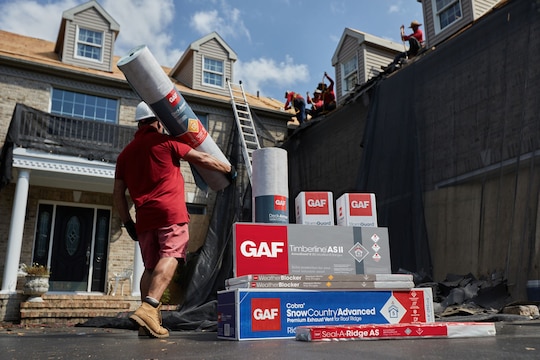
Repairing or replacing a damaged roof isn't always something that can be put on pause, even when finances are tight. Happily, there are options for financing the quality roof you want, even if you can't pay upfront.
If you do have an insurance claim, financing can help you cover the difference between what insurance pays out and the roof system that you want. In some states, you may also be able to use financing to cover the insurance deductible requirement.
Instead of one lump sum payment, financing roof repair lets you pay over time through manageable monthly payments that work with your budget. Read on to learn more about some options that may help you finance your roof repair.
Contractor Financing
Many contractors offer financing options that some homeowners might find beneficial. Simplicity, speed, and competitive loan rates are some of the major perks of contractor financing. Your contractor may offer a range of payment options, from accepting credit cards to different loan options.
Choosing a contractor who offers financing could help you take care of a necessary roofing project now.
The financing application process usually takes a matter of minutes and can often be done online. Information about interest rates, monthly payments, loan terms (typically between 1-15 years), and fees should be readily available. Some contractors even offer a zero-interest period on loans.
Credit Card
If you prefer to use your credit card for large purchases in order to earn rewards or give yourself more breathing room on payments, ask your contractor if they accept payment through credit cards. If you plan to pay back the money in the short term, consider using a credit card with a 0% introductory rate to avoid interest. These introductory rates are usually offered for 6-18 months, and then APRs may jump to 20% and higher.
Home Equity Loan and Line of Credit
You can borrow money against your home equity with home equity loans and home equity lines of credit (HELOC). Equity is the amount you could sell your home for minus how much you still owe in mortgage. Home equity loan rates range from 3.75% and 11.99% and HELOC rates range from 2.87% and 21%, according to Bankrate. It's important to remember that your home is the collateral, so if you default on your loan, your home could be sold as repayment.
To qualify, you typically need a debt-to-income ratio lower than 50%, a relatively good credit score, and at least 15-20% in home equity. Getting approved and receiving cash in hand may take a few weeks if you need to obtain an appraisal or other documentation.
Title I Property Improvement Loan Program
If your home equity is limited and you don't qualify for a home equity loan or line of credit, a government-backed FHA Title I fixed-rate loan could be a good option. To obtain an FHA Title I loan, "you need to own the property or have a long-term lease on it; fill out a loan application that shows you are a good credit risk; and execute a note agreeing to repay the loan," according to the U.S. Department of Housing and Urban Development. Loans under $7,500 are unsecured, meaning they require only a signature, while loans over $7,500 (and up to $25,000) may require your home as collateral.
VA Loans
Good news for veterans, active service members, and their spouses: the U.S. Department of Veterans Affairs offers a guaranteed loan program to help veterans and active service members buy a home or repair a primary residence. Some of the perks include low-interest rates and the removal of loan limits (per the Blue Water Navy Vietnam Veterans Act of 2019). These loans are easy to qualify for, even if you have lower credit or have declared bankruptcy in the past, and they typically require no down payment. You can apply for a Certificate of Eligibility to get started.
Personal Loans
Personal loans are another way of financing roof repair. Loan rates and terms will depend on how much you borrow, your credit background, your income, and other factors. Before signing on for a personal loan, get clear on repayment details and determine if the loan is secured or unsecured. Secured loans need collateral (such as your car or home) as insurance of loan repayment.
Personal loan interest rates are typically higher than other financing options and may have smaller loan sizes, so you may pay more to borrow the same amount of money and/or the loan may not cover the full cost of the repair.
If you have a roof repair on the horizon, financing can open up your options. Although GAF does not offer financing, many GAF factory-certified contractors* do. Find a contractor and get started on your roof repair today.
*Contractors enrolled in GAF certification programs are not employees or agents of GAF, and GAF does not control or otherwise supervise these independent businesses. Contractors may receive benefits, such as loyalty rewards points and discounts on marketing tools from GAF for participating in the program and offering GAF enhanced warranties, which require the use of a minimum amount of GAF products.
The information contained in this article was authored by a third party and is for informational purposes only. It is not intended to constitute financial, accounting, tax or legal advice. GAF does not guarantee the accuracy, reliability, and completeness of the information. In no event shall GAF be held responsible or liable for errors or omissions in the content or for the results, damages or losses caused by or in connection with the use of or reliance on the content.



